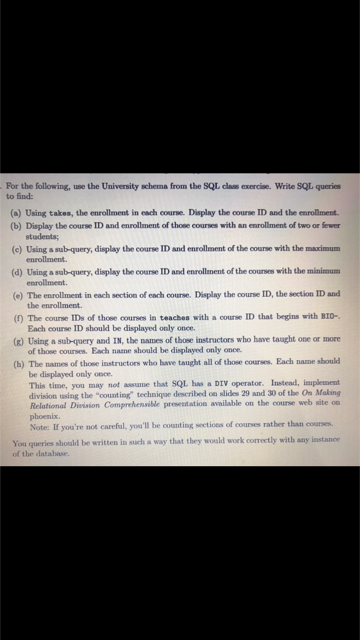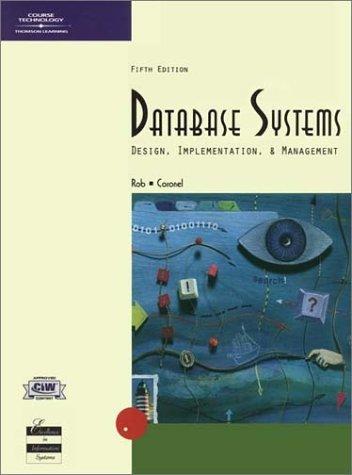Question
Hello can anyone help me out here, I can't make any sense into it. thank you University Schema to answer the question: create table classroom
Hello can anyone help me out here, I can't make any sense into it. thank you
University Schema to answer the question:
create table classroom (building varchar(15), room_number varchar(7), capacity numeric(4,0), primary key (building, room_number) );
create table department (dept_name varchar(20), building varchar(15), budget numeric(12,2) check (budget > 0), primary key (dept_name) );
create table course (course_id varchar(8), title varchar(50), dept_name varchar(20), credits numeric(2,0) check (credits > 0), primary key (course_id), foreign key (dept_name) references department on delete set null );
create table instructor (ID varchar(5), name varchar(20) not null, dept_name varchar(20), salary numeric(8,2) check (salary > 29000), primary key (ID), foreign key (dept_name) references department on delete set null );
create table section (course_id varchar(8), sec_id varchar(8), semester varchar(6) check (semester in ('Fall', 'Winter', 'Spring', 'Summer')), year numeric(4,0) check (year > 1701 and year
create table teaches (ID varchar(5), course_id varchar(8), sec_id varchar(8), semester varchar(6), year numeric(4,0), primary key (ID, course_id, sec_id, semester, year), foreign key (course_id,sec_id, semester, year) references section on delete cascade, foreign key (ID) references instructor on delete cascade );
create table student (ID varchar(5), name varchar(20) not null, dept_name varchar(20), tot_cred numeric(3,0) check (tot_cred >= 0), primary key (ID), foreign key (dept_name) references department on delete set null );
create table takes (ID varchar(5), course_id varchar(8), sec_id varchar(8), semester varchar(6), year numeric(4,0), grade varchar(2), primary key (ID, course_id, sec_id, semester, year), foreign key (course_id,sec_id, semester, year) references section on delete cascade, foreign key (ID) references student on delete cascade );
create table advisor (s_ID varchar(5), i_ID varchar(5), primary key (s_ID), foreign key (i_ID) references instructor (ID) on delete set null, foreign key (s_ID) references student (ID) on delete cascade );
create table time_slot (time_slot_id varchar(4), day varchar(1), start_hr numeric(2) check (start_hr >= 0 and start_hr = 0 and start_min = 0 and end_hr = 0 and end_min
create table prereq (course_id varchar(8), prereq_id varchar(8), primary key (course_id, prereq_id), foreign key (course_id) references course on delete cascade, foreign key (prereq_id) references course );

Step by Step Solution
There are 3 Steps involved in it
Step: 1

Get Instant Access to Expert-Tailored Solutions
See step-by-step solutions with expert insights and AI powered tools for academic success
Step: 2

Step: 3

Ace Your Homework with AI
Get the answers you need in no time with our AI-driven, step-by-step assistance
Get Started


